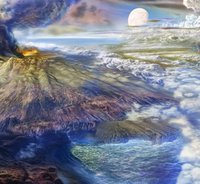
The present Earth-Moon system formed in the wake of a collision between a Mars-sized and Venus-sized planet. Tides strongly heated the interior of the Earth. A massive CO2 and water atmosphere blanketed the Earth. Choline and sulfur species made it opaque so heat escaped at the runaway greenhouse threshold. After ~10 m.y, the interior froze and water rained out. The surface temperature was ~200C and the CO2 pressures was ~200 bars. The Earth did not become inhabitable until the CO2 subducted into the mantle. Arc volcanics formed from CO2-rich oceanic crust. They were K-rich peralkaline and strongly reducing. Fluids in these rocks tend to stabilize ribose aiding production of RNA. This environment adds to the traditional serpentine environment under the ocean and on land. It may have left tracks in modern life. The ocean may well have had K/Na much greater than present, like cellular fluids. By ~3.8 Ga, the climate was clement and CO2 was near modern levels. Subducted material in the mantle may preserve evidence, but none has been found to date.
 Getting Under Europa’s Skin
Getting Under Europa’s Skin Tracing Formation and Evolution of Outer Solar System Bodies Through Stable Isotopes and Noble Gas Abundances
Tracing Formation and Evolution of Outer Solar System Bodies Through Stable Isotopes and Noble Gas Abundances Photosynthesis, a Planetary Revolution
Photosynthesis, a Planetary Revolution Xenon: King of the Gases
Xenon: King of the Gases